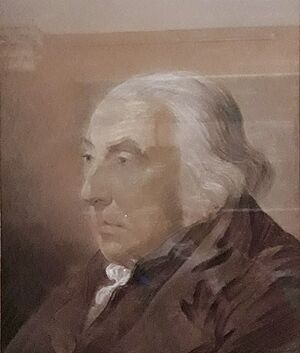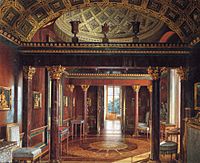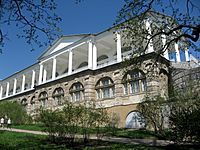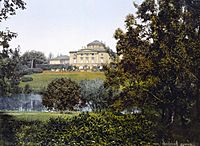Charles Cameron (architect) facts for kids
Quick facts for kids
Charles Cameron
|
|
|---|---|

Oil-painting signed by R. Hunter, Dublin, 1773, previously in the Townshend collection, Raynham Hall
|
|
| Born | c. 1745 |
| Died | 19 March 1812 (aged 66/67) |
| Occupation | Architect |
| Buildings | Main palace in Pavlovsk Cameron's Gallery and Cold Baths in Tsarskoye Selo |
| Projects | Parks of Pavlovsk, Sophia and Tsarskoye Selo |
Charles Cameron (1745 – 19 March 1812) was a Scottish architect who became very famous working for Empress Catherine the Great in Russia. Cameron was an early expert in neoclassical architecture, a style inspired by ancient Greek and Roman buildings. He was the main architect for the Tsarskoye Selo and Pavlovsk palaces, and the nearby new town of Sophia. He worked on these projects from his arrival in Russia in 1779 until Catherine's death in 1796.
Cameron focused mostly on designing country palaces and beautiful landscape gardens. He faced challenges when Emperor Paul took over, being dismissed twice. However, his career briefly restarted under Emperor Alexander I from 1803 to 1805. All of his most famous buildings can be seen in a single day's visit.
Cameron's British neoclassical style was quite unique in Russian architecture at the time. Most other architects were Italian, like Francesco Rastrelli and Giacomo Quarenghi. Even though he's not very well-known in his home country, Cameron is considered one of the greatest British artists to work abroad. Experts like Howard Colvin call him a major architect of the 1700s. He was a talented designer who helped bring the "Greek Revival" style to Russia.
Contents
Who Was Charles Cameron?
We don't know much about Charles Cameron's very early life. He was probably the son of Walter Cameron, a carpenter in London. However, Charles Cameron claimed he was related to the Camerons of Lochiel, a Scottish clan involved in a big historical event in 1745.
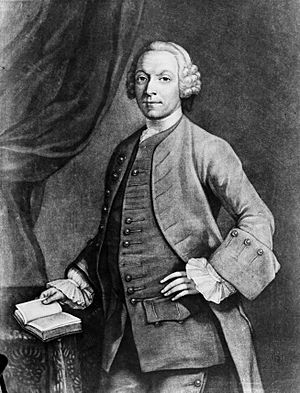
His father, Walter, was friends with Dr. Archibald Cameron, a famous Jacobite. Charles Cameron even used the Lochiel family symbol on his personal bookplate. However, modern researchers aren't sure if he was truly part of that famous family. Experts also disagree on his exact birth year, which could be 1743, 1745, or 1746.
Starting His Career
Cameron learned his skills in London, working with his father and with architect Isaac Ware. After Ware passed away in 1766, Cameron decided to continue his teacher's work on a new version of a book called Fabbriche Antiche. This project meant he had to travel to Italy to study ancient Roman buildings himself.
He spent 1767 in London, preparing drawings of buildings by Andrea Palladio. In 1768, he arrived in Rome. There, he studied the Baths of Titus and Nero's Domus Aurea. He even dug into parts of these old ruins that were only fully rediscovered much later. Some historians believe that in Rome, Cameron met another Charles Cameron, who was actually from the famous Lochiel clan. It's thought that Cameron might have used this other person's life story to make his own background sound more impressive.
Cameron returned from Italy around 1769. In 1772, he published his studies in a book called The Baths of the Romans explained and illustrated.... This book included scientific notes in both English and French.
We don't know much about Cameron's life between 1769 and when he moved to Russia in 1779. Records show he was involved in only one building project in London. This project caused financial problems for his father, Walter, who ended up in jail because of debt. Charles even sued his own father. Later, in 1791, when Cameron tried to join a group of architects in London, he was not allowed in because of these and other past difficulties that had affected his reputation in England.
Moving to Russia
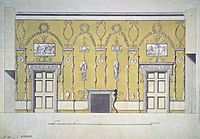
Empress Catherine the Great's taste in architecture changed over time. In the 1780s, she became very interested in Neoclassicism. She saw this new style as perfect for imperial art. She spent a lot of money hiring foreign architects and artists who were trained in this neoclassical way. Catherine specifically asked her agent, Baron Melchior Grimm, to hire Italian architects. She felt that French architects "know too much and build dreadful houses." Italian architects like Giacomo Quarenghi arrived in Russia after Cameron.
Cameron came to Russia in 1779, also invited by Catherine's agents. We don't know all the details of how he was hired. But on August 23, 1779, Catherine wrote excitedly that she was "very taken with Mr. Cameron, a Scot... great draughtsman, well versed in antique monuments and well known for his book on the Baths of Rome." She also mentioned that Cameron was supposedly raised at the Roman court of Prince James Stuart. Cameron first lived in Saint Petersburg, but soon moved to his own house in Tsarskoye Selo. This house was later taken from him by Emperor Paul.
Cameron, who was from London, didn't have much experience in landscaping before 1779. Some historians suggest he learned about it from his father-in-law, John Busch, who had been working in Tsarskoye Selo since 1771.
Tsarskoye Selo: Catherine's Favorite Place
Cameron's work in Russia began with expanding the Chinese Village in Tsarskoye Selo park. He used design ideas from William Chambers. The village's theater was already there, designed by other architects. Cameron's main additions were the living quarters and the Chinese Bridges over the canal. Later, during Emperor Paul's rule, these buildings were changed, and then rebuilt again in 1817.
From 1780 to 1784, Cameron redecorated the main Catherine Palace. This palace was originally built in the Rococo style by Bartolomeo Rastrelli in the 1750s. What started as a small update soon became the most luxurious rooms in the entire palace. These rooms reminded people of famous artists like Andrea Palladio and Raphael, but they also had Cameron's unique style. Catherine was very impressed, saying in 1771, "There are not yet but two rooms to do and there one rushes, because just here one sees nothing to equal it. I confess that I myself will not tire during nine weeks of watching this."
Catherine had another special project for Cameron. She wanted a new, simpler neoclassical building in Tsarskoye Selo, near the old Catherine Palace. Another architect, Clerisseau, had drawn plans for a huge and expensive Roman-style building, which Catherine rejected. However, these plans later influenced Cameron.
In 1782, Cameron started his first standalone building, the Cold Baths. This was a two-story bathhouse that mixed Italian and Greek classical styles. It had very luxurious rooms, especially the Agate Pavilion. From 1784 to 1787, he added a two-story gallery, known as Cameron's Gallery. This gallery had a strong stone ground floor and a light, white upper floor with widely spaced columns. The gallery was decorated with statues of famous poets and thinkers. It became Catherine's favorite place to walk for many years. On one side, it had a formal garden, and on the other, an English landscape park.
At the start of the Gallery project, Cameron helped Catherine find other skilled workers. He hired 73 Scotsmen to work in Tsarskoye Selo, and many brought their families. This caused a small protest from the British government! The group was too large for Cameron's project alone, so many of the Scots went to work on other projects.
Sophia: A Model Town
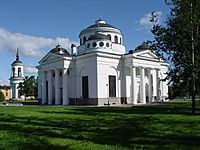
The town of Sophia, a model town, was built near Tsarskoye Selo following Cameron's design. It was planned so that it could be seen from the walkways of Cameron's Gallery. The town was meant to represent Constantinople, a city Catherine dreamed of conquering. The name of the town and its cathedral clearly referred to Hagia Sophia, a famous church in Constantinople. Catherine wanted the streets of Sophia to connect smoothly with the roads in Tsarskoye Selo park. Cameron designed the streets to look as if they all spread out from the Gallery. At night, when Catherine was at Tsarskoye, the streets were brightly lit.
More historical symbols were placed throughout the park. For example, a lake with a rostral column (a column decorated with ship prows) represented the Black Sea. Doric ruins symbolized the past power of Ancient Greece. These decorative buildings, called follies, were placed along the road to Catherine Palace. They also served as a beautiful setting for parades and celebrations when important guests visited.
Historian Peter Hayden noticed similarities between Cameron's landscaping in Sophia and the park at Stowe House in England. For instance, Cameron's Temple of Memory looked like the Temple of Concord and Victory at Stowe. Another direct copy from Stowe was the Pyramid Tomb, built over the graves of Catherine's three Italian greyhounds. This tomb still exists today, but the Temple of Memory was torn down by Emperor Paul in 1797.
Pavlovsk: A Grand Park
Pavlovsk is the largest landscape park in 18th-century Russia, covering 1,500 acres. Many architects worked on it over time, starting with Cameron and ending with Carlo Rossi. Cameron built the main part of the palace that still stands today. He also designed the Temple of Friendship, Private Gardens, Aviary, Apollo Colonnade, and the Lime Avenue. He planned the original landscape. However, the overall design of Pavlovsk should also be credited to Empress Maria Feodorovna.
The Temple of Friendship was the first building in Pavlovsk, followed by the main palace. Cameron's design for Pavlovsk was very different from what Paul wanted for an imperial home. It didn't have moats or forts, which Paul loved. It was a more private and peaceful place.
Cameron often had disagreements with Paul and Maria, starting around 1781. Maria complained about Cameron's delays as early as 1782. Paul and Maria had limited money, so they watched Cameron's progress closely and often limited his grand, expensive plans. Cameron also showed signs of disliking their management. By 1785, their disagreements became public. Cameron argued with Paul about the costs of Pavlovsk, and Paul disliked Cameron because he was Catherine's favorite. Between 1786 and 1789, Cameron's duties at Pavlovsk were taken over by an Italian architect named Vincenzo Brenna. Even though Paul dismissed him from Pavlovsk, Cameron continued working on Catherine's own projects until she died in 1796.
Later Years
When Paul became emperor in 1796, he fired Cameron from all his projects and took away his house in Tsarskoye Selo. Cameron faced financial difficulties and had to sell his collection of books. We don't know much about what he did during Paul's reign. Some say he redesigned the Baturyn Palace, but modern researchers believe it was a team effort, and Cameron's exact role isn't clear.
It was also thought that Cameron left Russia for England around 1800-1801. However, this isn't true. He was working in Pavlovsk during that time, which was then owned by Maria Fyodorovna. There, he built the Ionic Pavilion of Three Graces.
When Alexander became emperor in March 1801, he appointed Cameron as the chief architect of the Russian Admiralty. During this short period (1802–1805), Cameron designed the Naval Hospital in Oranienbaum. He also drew plans for two naval cathedrals that were never built. He also worked in Pavlovsk, helping to repair the palace after a fire. In 1805, Cameron finally retired. His job at the Admiralty was taken over by Andreyan Zakharov. Some historians noted that Cameron, who once built Catherine's grand dreams, was not very interested in building military barracks and repairing gates.
Personal Life
Cameron's personality is still a bit of a mystery. He was described as "proud, distant, and difficult," and he often upset people. He didn't join in the social life of other English people living in Saint Petersburg. He had few Russian friends, didn't speak Russian, and was sometimes disliked for acting superior.
In 1784, Cameron married Catherine Busch, the daughter of the imperial gardener, John Busch. They had a daughter named Mary. Mary Cameron later left Russia in 1798. Her husband, James Grange, returned to Russia in 1803. Some believe he might have helped Cameron get his job back from 1803 to 1805. By 1839, the Granges had seven children.
In his retirement, Cameron and his wife lived in Paul's favorite palace, Saint Michael's Castle. This large, unfinished castle was turned into living quarters for many people, including the Camerons. Cameron passed away in 1812, before Napoleon's invasion of Russia. His wife received a pension from the Russian government, sold Cameron's library, and either went back to England or died in Saint Petersburg.
Images for kids
-
Dr Archibald Cameron of Lochiel (1707–1753)


